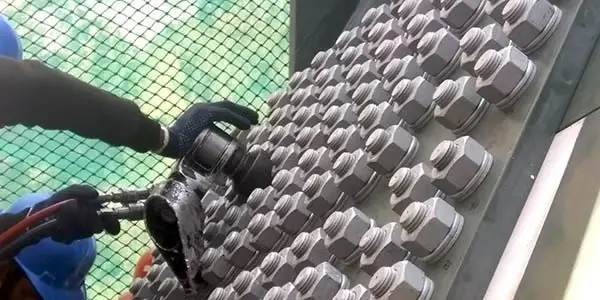When it comes to bolted joints, utmost importance is given to joint reliability in applications such as pressure vessels & pipe flanges in oil & gas for leakage-free joints and in automotive/machinery for guarding against vibration. When it comes to infrastructural joints of a long-term nature such as bridges and towers, the Fit-it-Forget approach is commonly seen.
Joint reliability is determined by various factors, bolt load accuracy playing a predominantly critical role among these. To control the impact of external factors such as vibration and temperature on bolt load, we need to understand the concept of Controlled Bolting Mechanism which is a scientific method of bolting.
Factors to be Considered
It is very unlikely that the bolts in infrastructure joints will be re-opened in its lifetime. Since bolting is more of permanent nature, the nuts are tightened or bolts are loaded to a higher degree than other types of bolts. The bolts usually used in infrastructure are of Grade / Property Class 8.8, 10.9, etc. Sometimes HSFG (High Strength Friction Grip) bolts are also used. One standard which specifies bolting for high strength structural bolting is EN14399. The bolt & nut assemblies are as per EN 14399-4 which normally consists of one bolt, one nut, and two washers. All these bolts would be preloaded*, the pre-load should be more than the load that would be acting on the bolts when the bolting is complete, and the structure loaded with the active loads like weight, etc.
Lubrication is a significant factor in achieving bolt load calculation through torqueing tools. In general, the bolts are pre-lubricated using coatings as specified to suit the environment/joint on which they will be used. The bolt manufacturer specifies the load that will be generated in the bolt when applying a specific torque value. This is done keeping in mind any deterioration of the lubricant during storage, and the time lapse between manufacture and the installation of the bolts. The load generated in bolts can be verified at sites by random sampling using load-cells or bolt tension measuring devices.
Due to time lapse between procurement, storage and actual installation of the bolts, the bolt load accuracy is impacted by the upkeep and maintenance of fasteners. Unfavorable site conditions do not allow for proper storage and upkeep, which may affect changes in fastener’s physical and mechanical properties, which causes the difference in actual load calculation vs current load requirement. This calls for pre-inspection of bolts, the right selection of tool for higher productivity and quality; proper storage, tools which can give part code wise data recording facility through the latest technology.
Choosing the Right Torque Wrench
Infrastructure bolts are tightened/preloaded using mechanized torque wrenches which come with the facility of pre-setting the torque value and achieving bolt load accuracy in a calculated manner. These tools record and notify torque values achieved while torqueing, which is not possible with manual tightening methods. A torque wrench can be hydraulic, pneumatic, battery or electrically powered. However, one should take into account factors such as torque required, location of the joints, ease of use, etc. while selecting the right tool.
Battery torque wrenches, the latest in controlled bolting, are quite compact, have good power to weight ratio and come with documentation feature that helps the quality department to download bolting data for records. In the latest technological advancement, the innovative pumps for the hydraulic torque wrenches come with data recording facility that gives the status of torqueing for every single bolt. They also provide audio & visual warning on successful completion of bolting and errors, if any. The routine inspection activities become easy due to data monitoring. Since historic data is available with the latest torqueing tools, inspection scheduling patterns become easier, which goes a long way in cost control, data transparency, data identification, and traceability.
While hydraulic torque wrenches offer the best power to weight ratio, they can be difficult for working on bolted joints at a height, due to the requirement of a power pack, and are also relatively slower than battery torque wrenches. The pneumatic torque wrenches need compressed air, so while working at height there could be loss in air pressure depending on the line length. The electric torque wrenches are quite heavy for a given torque compared to other types of tools.
Achieving Bolt Load Accuracy
Side loading on reaction points is another factor that affects bolt load accuracy and tool life. It is important to be attentive about the reaction points of the torque wrenches and the requirements of any customised reaction arms. The next-gen bolting is about the usage of special washers and drives that eliminate the requirement of reaction arms.
There are special washers that ascertain the achievement of the correct bolt load which maybe through some jelly squirting or by flattening of the projections on the washers.
Documented procedures for bolting and skill of operators play a crucial role in achieving bolt load. ASME recommends deployment of certified bolting personnel for any bolting job*. Equally or more important attention should be paid to the safety of the operators by training them in the safe operation of the tools and adherence to the systems and procedures without taking any shortcuts to achieve the objectives.
To summarise, the achievement of the required bolt load is a result of true combination of the right tool and hardware selection, proper procedure, lubrication, operator skill on tool operation and safety.
*Bolts are said to be pre-loaded as the loading (tightening) happens prior to the induction of active loads on the joint.
*ASME offers Bolting Specialist Qualification program through its Authorised Training providers.
This article was also published in B2B Purchase magazine.


